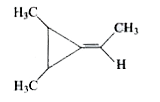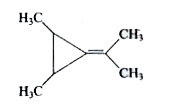Which one of the following can shown optical isomerism ?
FeSO4.7H2O
K3[Cr(C2O4)3]
K3[Fe(CN)6]
[Cr(NH3)6]Cl3
The correct Answer is:B
To determine which of the given compounds can show optical isomerism, we need to analyze each option based on the criteria for optical isomerism. Optical isomers (enantiomers) are compounds that have the same molecular formula but differ in the spatial arrangement of atoms, resulting in non-superimposable mirror images. A compound must lack any symmetry (such as a plane of symmetry) to exhibit optical isomerism.
1. Understanding Optical Isomerism:
- Optical isomers are compounds that are mirror images of each other and cannot be superimposed. This typically occurs in chiral molecules, which lack symmetry.
2. Analyzing Each Option:
- Option 1: FeSO4·7H2O (Green Vitriol):
- This compound is octahedral in structure due to the six water molecules coordinated to iron.
- The presence of symmetry (specifically, a plane of symmetry) means it cannot show optical isomerism.
- Conclusion: Does not show optical isomerism.
- Option 2: K3(Cr(C2O4)3):
- This compound has chromium coordinated to three bidentate oxalate ligands, resulting in a coordination number of six.
- The arrangement lacks symmetry, making it possible to have non-superimposable mirror images.
- Conclusion: Can show optical isomerism.
- Option 3: K3(Fe(CN)6):
- This is also an octahedral complex with six cyanide ligands.
- The presence of symmetry (multiple planes of symmetry) indicates it cannot show optical isomerism.
- Conclusion: Does not show optical isomerism.
- Option 4: (Cr(NH3)6)Cl3:
- This octahedral complex has six ammonia ligands coordinated to chromium.
- Similar to the previous case, it has symmetry and thus cannot exhibit optical isomerism.
- Conclusion: Does not show optical isomerism.
3. Final Conclusion:
- The only compound that can show optical isomerism is Option 2: K3(Cr(C2O4)3).
Answer:
Option 2: K3(Cr(C2O4)3) can show optical isomerism.
- Optical isomers are compounds that are mirror images of each other and cannot be superimposed. This typically occurs in chiral molecules, which lack symmetry.
- Option 1: FeSO4·7H2O (Green Vitriol):
- This compound is octahedral in structure due to the six water molecules coordinated to iron.
- The presence of symmetry (specifically, a plane of symmetry) means it cannot show optical isomerism.
- Conclusion: Does not show optical isomerism.
- This compound has chromium coordinated to three bidentate oxalate ligands, resulting in a coordination number of six.
- The arrangement lacks symmetry, making it possible to have non-superimposable mirror images.
- Conclusion: Can show optical isomerism.
- This is also an octahedral complex with six cyanide ligands.
- The presence of symmetry (multiple planes of symmetry) indicates it cannot show optical isomerism.
- Conclusion: Does not show optical isomerism.
- This octahedral complex has six ammonia ligands coordinated to chromium.
- Similar to the previous case, it has symmetry and thus cannot exhibit optical isomerism.
- Conclusion: Does not show optical isomerism.
- The only compound that can show optical isomerism is Option 2: K3(Cr(C2O4)3).
Option 2: K3(Cr(C2O4)3) can show optical isomerism.
Similar Questions
Knowledge Check
- Question 1 - Select One
Which of the following will not show optical isomerism ?
ACl−CH=C=CH−ClBBr−CH=C=CH−BrC D
D
- Question 2 - Select One
Which of the following compound shows optical isomerism ?
ACH3CH2CH3BCH2OHCHOHCH2OHCCH3CHOHC2H5DNone of these - Question 3 - Select One
Which of the following will not show optical isomerism as well as geometrical isomerism ?
A B
B C
C D
D
Which of the following can show geometrical isomerism?
View SolutionWhich of the following does not show optical isomerism ?
View SolutionWhich of the following compound show optical isomerism?
View SolutionWhich of the following compound show optical isomerism?
View SolutionWhich of the following will not show optical isomerism?
View Solution


